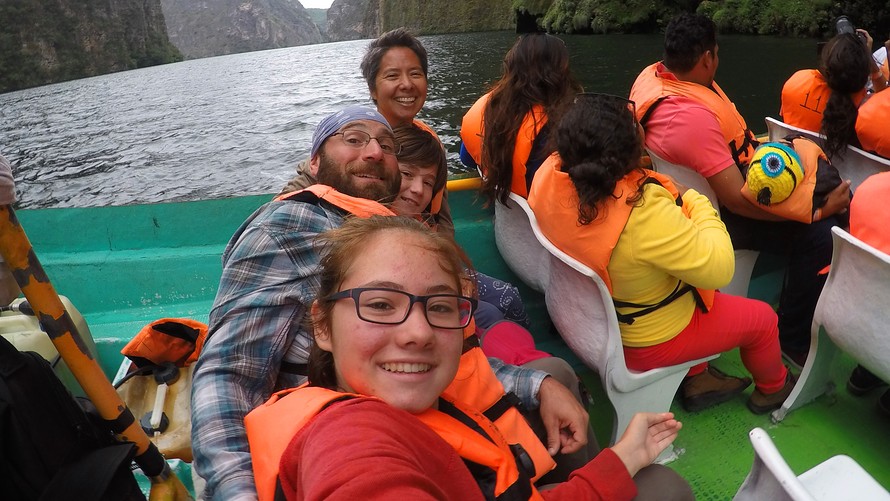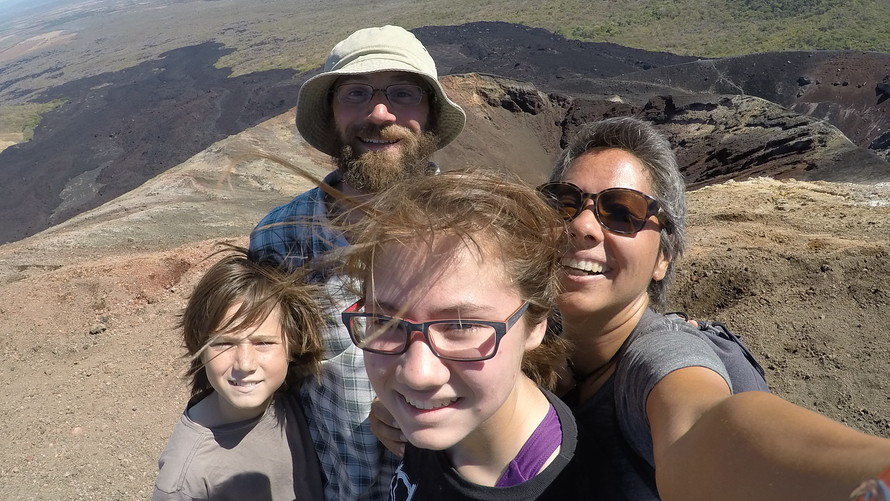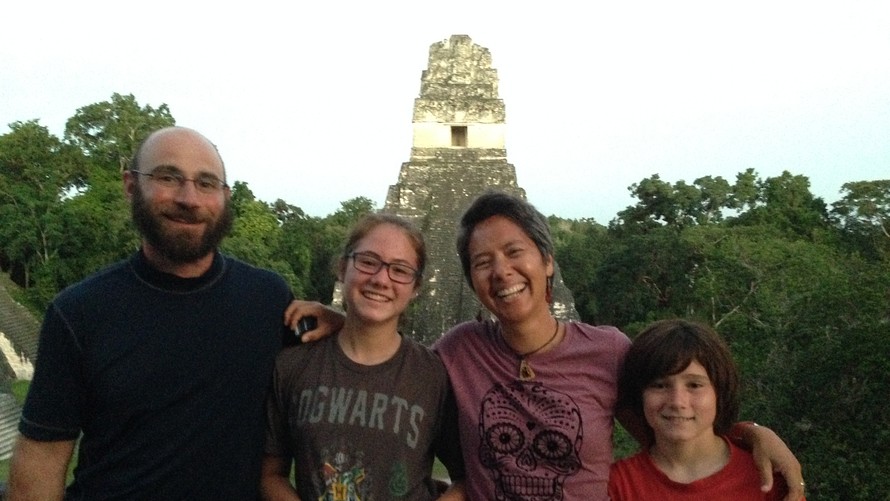For eight years, this suburban Virginia couple dreamed of traveling the world with their kids.
They just didn’t know how they’d do it.
“The idea was to travel for a year, at first we thought we would do it by plane,” attorney Paul Carlino, 49, tells Marketwatch. But then the family spent a couple weeks traveling through Hawaii in a rented Volkswagen VWAGY, -0.55% van, and after that they knew they were heading for #vanlife.
“I was immediately on Craigslist looking for vans after that trip,” jokes Paul’s wife, attorney Rebecca Eichler, 49.
In 2015, the couple — whose kids were then 10 and 13 (Rebecca says they chose to do it at these ages because “they weren’t at pivotal years in school”) — hit the road in a 1985 VW Vanagon van. They spent $6,500 on the van and $7,000 refurbishing it with a new transmission, shocks, gaskets, brake hoses and more; they even glued eyelashes on the headlights and named the van Wesley, after the main character in their favorite movie “The Princess Bride.” Paul got a year-long leave of absence from his job to take the trip; Rebecca, who runs her own immigration firm, put her work on hold for a year; and the couple homeschooled the children during the journey.
“Despite the hard times, we could see the resiliency in the kids as things progressed. They were able to bounce back from disappointment and hard situations — hot weather, bugs, foods that they didn’t necessarily love but ate because that is what there was in this or that village.”
The plan was to spend a year traveling through Central and South America all the way down to the tip of Argentina — but after their first week in Mexico, where they stayed in the same spot for a week, they decided to take the trip slower and just do Central America. The family ended up going roughly 15,000 miles — they aren’t exactly sure how far as the odometer broke at some point in El Salvador and they didn’t fix it until they reached Nicaragua a few weeks later — through seven countries including Mexico, El Salvador, Guatemala, Honduras, Costa Rica, Nicaragua and Panama.
 Paul Carlino & Rebecca Eichler
Paul Carlino & Rebecca Eichler
Among the highlights: They spent a few weeks on Ometepe Island (in the middle of a lake in Nicaragua) making chocolate with an American woman who had a biodynamic farm there (they found her through the WorkAway program, which connects travelers who are looking for a place to stay and willing to do work for it).
“She had no electricity, dirt floors, chickens were running around everywhere, her water came from a hose connected to a spring … There were glass bottles everywhere where she said she was trapping earth spirits.” They helped her make chocolate bars — that’s how she earned money, Rebecca says — that she sold to hotels, tourists, “and a bunch to the commune up the hill” where the residents might have sometimes “been a little stoned,” Paul jokes.
They also did some building for a riverside eco-lodge in Costa Rica, witnessed an olive ridley turtle nesting in Mexico, sledded down a volcano in Nicaragua, and crossed the Panama Canal onboard a catamaran. They did this by becoming volunteer line handlers — in which you secure mooring lines on a boat; the Panamanian government requires four line handlers on a boat when crossing the canal. “Someone we had met earlier in the trip gave us the idea. It was an adventure, we spent the night on a catamaran that had come all the way from Portugal,” Paul says.
“We’d do it all again in a heartbeat,” says Paul — who adds that they’ve already been talking the two of them taking that trip once the kids graduate from high school. Here’s what the trip cost, what the kids really thought about it, and more.
 Paul Carlino & Rebecca Eichler
Paul Carlino & Rebecca Eichler
The cost:
The couple saved for eight years to pay for the trip, scrimping on housing (they continued to live in their roughly 1200-square-foot home in Alexandria even after they had two kids). They also didn’t have cable TV, lived with hand-me-down furniture and clothing instead of new, and drove old cars as long as they lasted. Rebecca adds that the couple worked to repay their student loans and mortgage as soon as they could, never carried a balance on their credit cards. “Our lifelong philosophy is to be cheap,” Paul writes on the family’s website, where they chronicled the trip and its costs.
Paul documented the costs of the trip, and estimates that they spent $36,000 on the year (not including the cost of the van and its repairs, and health insurance for the year, which costs upwards of $2,000 for the year (they got a travel insurance policy that did not cover them in the U.S.) The biggest cost was food for the family, which he estimates was about $12,000 for the year; that was followed by accommodations at about $10,000 for the year. Paul jokes that he wanted the family to sleep in the van the whole time, but “in an effort to not give them too much to talk about in therapy later,” he jokes, he agreed to hotels and AirBnBs sometimes (usually when it was too hot to sleep in the van).
Entertainment came in at about $3,500 a year — they did everything from rock climbing to surfing lessons to museums and carnivals — and miscellaneous expenses (purchases like laundry, gas, SIM cards for the phone and haircuts) cost about $5,500.
 Paul Carlino & Rebecca Eichler
Paul Carlino & Rebecca Eichler
The kids:
It was certainly an adventure for the kids — who did everything from ziplining to learning to surf to jumping off waterfalls — but it wasn’t always easy for them. One of the big challenges for the kids was not having peers their age with them at all times, as well as the language barrier, Rebecca says: “So, when we did find English speaking kids, we tended to stay put where they were until they moved on.”
Their daughter, who was 13 at the time, struggled with may parts of the trip, says Rebecca, adding that “13 is a challenging age to be anywhere” and noting that “we’ve got lots of photos of her holding her hand in front of the camera as if warding off the paparazzi.” Their 10-year-old son was enthusiastic for most of the trip though, “always up for swimming, exploring, and trying new foods,” Rebecca says. Now, that’s flipped. “Once we were back, she was proud of it, whereas our son who is now 13 says he will never get in the van again.”
“Despite the hard times, we could see the resiliency in the kids as things progressed. They were able to bounce back from disappointment and hard situations — hot weather, bugs, foods that they didn’t necessarily love but ate because that is what there was in this or that village. They also gained a perspective, first in a sense of understanding how privileged we are to be born and raised in the US,” Rebecca says.
When the year was up:
The couple returned to their regular jobs in 2016, but after a year spent on the road, things felt different. “We came back and were very changed. It’s hard to fit back into that same life,” Paul says. “We met so many people doing different things, taking different paths — they’d all be sitting on the same beach but from different paths.”
So in January 2018 the couple moved to San Miguel de Allende in the highlands of Mexico, where their cost of living is a third of what it was in the U.S. To earn money and pay private school tuition for the kids, they rent out their house in Alexandria; they earn extra money for everything else by freelance writing, running Spanish courses for U.S. professionals and doing various other odd jobs (tax return preparation and brewing and selling kombucha).
As a result of the van trip and seeing how other people lived, “We realized we didn’t have to go to a job every day. We can choose how we want to live our lives — do what we want,” Paul says. “It is not an impossible dream — there are communities of people out there doing this — single people, couples, families. If they want to, they can.”







